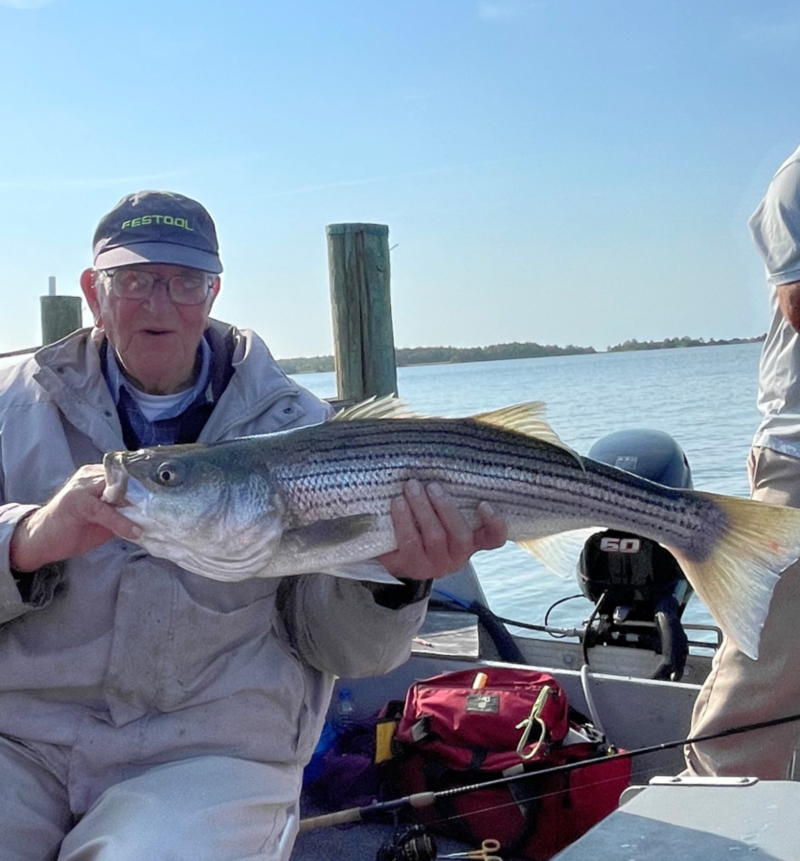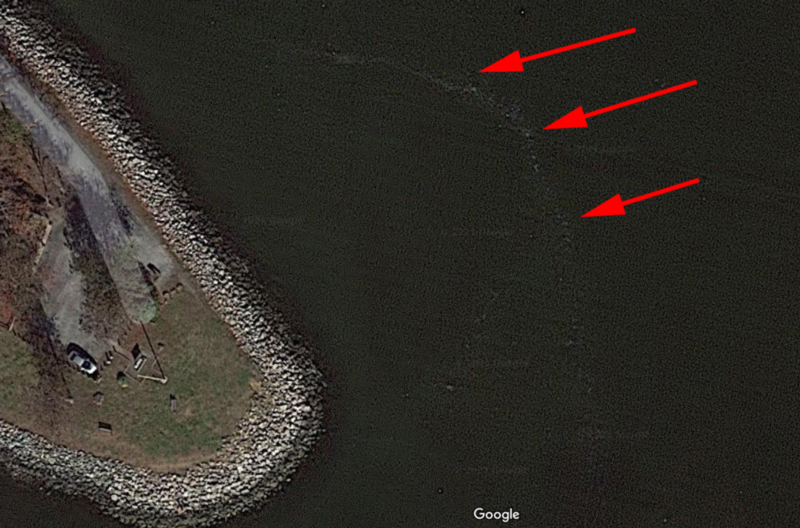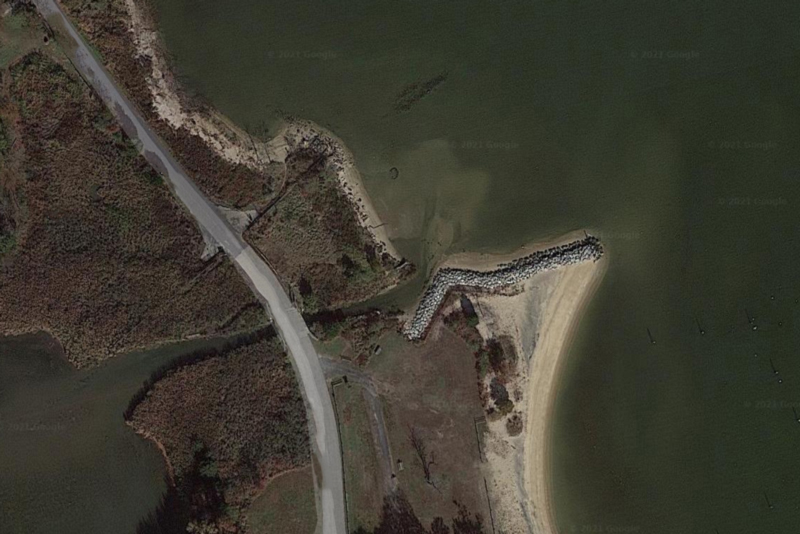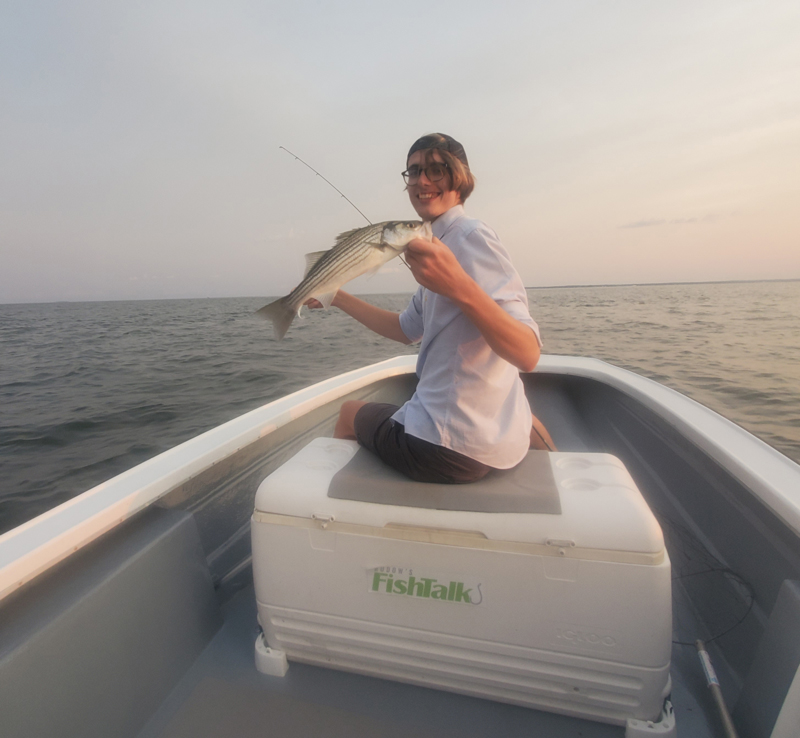My Brother once commented “Fish are where you find them.” We laughed, but what could be closer to the truth? Striped bass, rockfish as we call them in Maryland, are fairly easy to catch once you find them, but the finding is the tough part. Fortunately, if you are a light tackle angler fishing any of the rivers feeding the Chesapeake, there are some common clues to successful angling. Mainly I am speaking to anglers fishing artificial lures in the shallows, but these rules could apply to trollers and live bait fishermen as well.

Tide and current are the most important factors leading to locating stripers. When current meets an obstruction to its flow, it speeds up. This causes baitfish, crabs, or whatever the predators may be hunting to become disoriented and much more subject to being intercepted. Rockfish sense this and tend to congregate in such places.
Rockfish in the Rips
The obstruction itself is usually some form of a sudden change in depth. If the change is abrupt enough, this causes what we commonly refer to as a “rip.” On the surface it looks like a line of disturbed water which remains more or less in the same place. Rips can be tough to spot at first but the more of them you see the easier they are to identify. Long shorelines that face the tide can create tidal speeds that can show rips, but you can only find them by close exploration. Some rips will only produce on an ebbing tide, some on a flooding tide, and some on both tides.

When first exploring to find productive spots and locate rips in a tributary, it may be best to check the shorelines when fishing alone or with a partner who’s happy to just be on the water, regardless of how many fish get caught. That way you don’t have the burden of “having” to catch fish, because these exploration trips are often fruitless.
Structural Stripers
There are lots of other things in a tributary that stripers are attracted to, that are in plain sight. Stuff like duck blinds (one of my favorites), day markers, rip-rap, jetties, bulkheads, and sometimes just a pole or a piling may hold fish. They all deserve to be checked out. Because of river dynamics that I do not always understand, some will be good, and some will not.
A single piling or day marker in the right spot may be a fish-magnet and even though it may only hold one fish, if you can depend on a fish being there, that’s the limit in Maryland waters today. In the spring and early summer when young of the year alewives (menhaden) are too small to interest a legal rockfish, they feed on small finfish like white perch, spot, and croaker. The stripers may hold close in the wake of the day marker or pole to ambush the unsuspecting perch as they pass. Those stripers are often suckers for a bucktail and twister combo.
Another common ambush spot is the shade line from a duck blind or a bridge. Bait fish have a difficult time detecting the danger that lies behind that line. It makes you wonder how rockfish got so smart in just a few years — it took me a half a lifetime to figure that out.

The tidal ponds that are plentiful on many tributary rivers can also be a bonanza. The outlets of tidal ponds send crabs, minnows, and grass shrimp into the mouths of waiting rockfish. But they can only be found by close scrutiny of shorelines or by using maps, because the outlets themselves are often obscure. Also, these pond outlets are generally only productive on a falling tide and then only until the receding water becomes too shallow to hold rockfish.
Some great baits to use while exploring tributary shallows are shad bodies and surface plugs. Even a slight tap or swirl is enough to warrant a return trip. And always remember, many of the fish you catch will be undersized, so take special care of them as you remove the hook and place the fish back into the water. They are the fish you will be catching next year — and by then, they may not be undersized anymore.
Small Boats, Big Fish
While many anglers run right out of the tributaries to fish the open Bay, the quality of the fishing inside the rivers can be just as good. Plus, the tribs all offer waters that can be fished with very small, inexpensive boats and/or kayaks. Whether you’re just getting started fishing on the Bay or you’re an old salt, think twice before leaving these protected waters so quickly.

-By Chuck Prahl
Editor’s Note: Author Chuck Prahl has been fishing on the bay for decades longer than most of us have been alive, has run charters, has run tackle shops, and has written for multiple newspapers and magazines. He hasn’t done much writing in recent years and we at FishTalk are utterly thrilled to have the privilege of bringing Chesapeake Bay anglers his newest article.
Sign up here to get the weekly FishTalk Chesapeake Bay and Mid-Atlantic fishing reports in your email inbox, every Friday by noon.